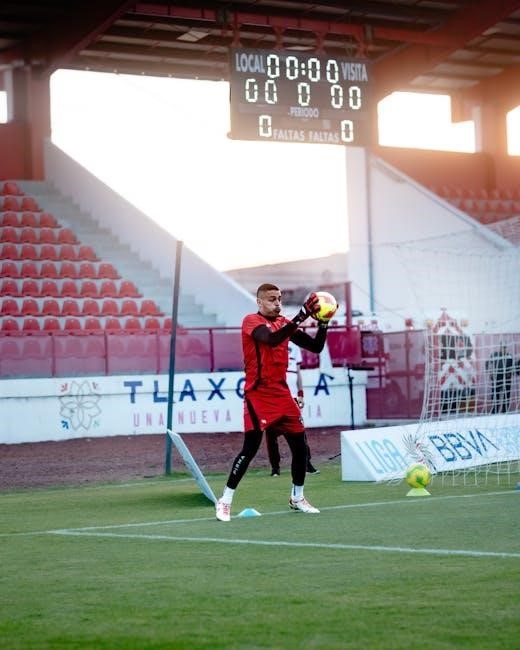
This comprehensive guide provides 42 structured soccer drills, categorized by skill level and type, offering a detailed approach to improving technical, tactical, and physical skills effectively.
Importance of Structured Soccer Practice Drills
Structured soccer practice drills are essential for improving technical skills, tactical understanding, and physical fitness. They provide a focused approach to developing specific abilities, ensuring players progress systematically. Coaches can design drills to address weaknesses and enhance strengths, creating a balanced team. These drills also promote consistency and repetition, which are key to mastering soccer fundamentals. By categorizing drills by skill level and type, coaches can tailor sessions to meet the needs of all players. This structured approach not only improves individual performance but also fosters teamwork and strategic play, leading to better overall team performance.
- Enhances technical proficiency.
- Improves tactical awareness.
- Boosts physical conditioning.
- Supports player development at all levels.
What to Expect in a Soccer Practice Drills PDF
A soccer practice drills PDF typically includes a variety of exercises designed to improve technical, tactical, and physical skills. It often features drills categorized by skill level (Beginner, Intermediate, Advanced) and by type, such as dribbling, passing, shooting, and defensive drills. The guide may also include sample practice plans, emphasizing adaptability to suit different player needs. Additionally, it provides clear instructions, diagrams, and coaching objectives to ensure effective implementation. This resource is invaluable for coaches and players seeking structured and diverse training sessions to enhance overall performance and teamwork.
- Drills categorized by skill level and type.
- Sample practice plans for structured sessions.
- Clear instructions and coaching objectives.
- Focus on improving technical and tactical skills.
Benefits of Using PDF Format for Soccer Drills
The PDF format offers numerous advantages for soccer coaches and players. It provides easy access to structured drills, enabling convenient planning and execution of training sessions. PDFs are portable and can be viewed on multiple devices, making them ideal for on-field use. They also retain formatting, ensuring clarity and consistency in drill instructions. Additionally, PDFs can be downloaded and printed, allowing coaches to distribute physical copies during practices. This format is cost-effective and often free, providing valuable resources without financial burden. Overall, PDFs are a practical and efficient tool for enhancing soccer skills and team performance.
- Portable and accessible on multiple devices.
- Retains formatting for clear instructions.
- Downloadable and printable for convenience.
- Cost-effective and often free.
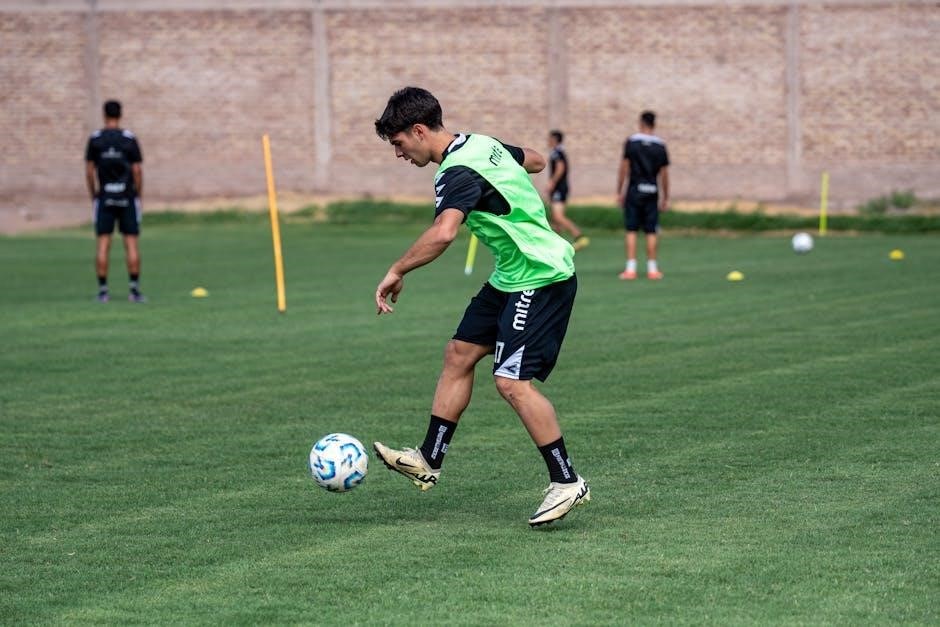
Categories of Soccer Practice Drills
Soccer practice drills are categorized into specific skill areas: dribbling, passing, shooting, defensive, team play, and goalkeeping, each designed to improve particular aspects of the game.
- Dribbling drills
- Passing drills
- Shooting drills
- Defensive drills
- Team play drills
- Goalkeeping drills
Beginner Soccer Drills
Beginner soccer drills focus on developing fundamental skills and building confidence. These drills emphasize basic ball control, simple passing, and shooting techniques. Players learn proper dribbling mechanics, such as using the inside, outside, and sole of the foot. Passing drills include short, accurate passes to teammates, while shooting drills focus on striking the ball with precision. Defensive basics, like proper stance and movement, are also introduced. These exercises are designed to create a solid foundation for more advanced skills, ensuring players progress smoothly and enjoyably. They are essential for new players to grasp the game’s essentials effectively.
Intermediate Soccer Drills
Intermediate soccer drills build on foundational skills, introducing more complexity and game-like scenarios. Players refine dribbling techniques, such as beating defenders with moves like step-overs and feints. Passing drills focus on weighted, long-distance balls and one-twos. Shooting exercises incorporate volleys and headers, while defensive drills emphasize positioning and tackling. Small-sided games and dynamic exercises improve decision-making and fitness. These drills aim to enhance technical proficiency, tactical awareness, and physical conditioning, preparing players for competitive play. They bridge the gap between basic skills and advanced techniques, fostering well-rounded development.
Advanced Soccer Drills
Advanced soccer drills are designed for experienced players, focusing on refining skills and tactical expertise. These drills emphasize complex movements, such as advanced dribbling techniques, precision long-range passing, and powerful, accurate shooting. Defensive drills include high-pressure scenarios, advanced positioning, and interception strategies. Small-sided games and high-intensity interval training are also incorporated to simulate match conditions. These exercises aim to enhance speed, agility, and decision-making under pressure. Advanced drills prepare players for competitive play by challenging them to master intricate skills and adapt to dynamic situations, ensuring they reach peak performance levels.
Dribbling Drills
Dribbling drills enhance ball control, speed, and confidence. Players practice intricate footwork, agility, and decision-making to outplay defenders and create scoring opportunities in tight spaces effectively.
Basic Dribbling Techniques
Mastering basic dribbling techniques is fundamental for any soccer player. These drills focus on developing ball control, balance, and coordination. Players learn foundational moves like inside cuts, outside cuts, and step-overs to manipulate the ball effectively. Emphasis is placed on keeping the ball close, using different parts of the foot, and maintaining proper body positioning. These exercises build confidence and lay the groundwork for more complex dribbling skills. By practicing these techniques consistently, players improve their ability to control the ball in tight spaces and under pressure, preparing them for advanced drills and game situations.
Cone Ball Control Drill
The Cone Ball Control Drill is a foundational exercise to enhance dribbling precision and agility. Set up cones in a straight line or zigzag pattern, spacing them 2-3 feet apart. Players weave through the cones using the inside, outside, and sole of their foot, maintaining close control. Emphasize quick direction changes and balanced movement. This drill improves ball manipulation, balance, and the ability to navigate tight spaces. Perform at varying speeds to challenge coordination and composure. Mastery of this drill builds the confidence and skill needed for advanced dribbling techniques and real-game scenarios.
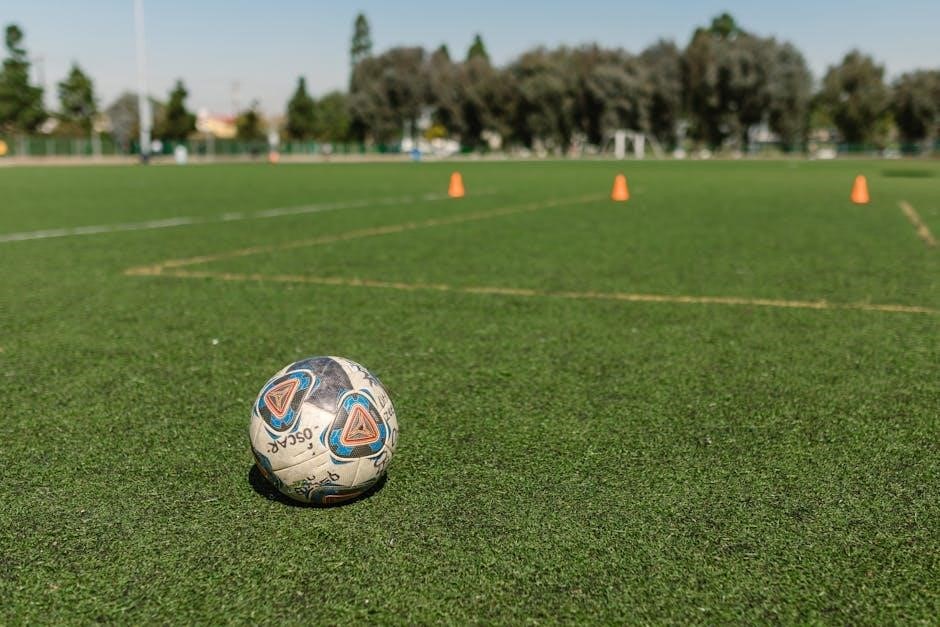
Dribbling Through Cones
Dribbling Through Cones
Dribbling Through Cones is an essential drill to refine ball control, agility, and decision-making. Arrange cones in a straight or zigzag pattern, spaced 3-5 feet apart. Players start at one end and navigate through the course, using the inside, outside, and sole of their foot to maintain possession. Emphasize keeping the ball close, quick changes of direction, and balanced movement. Gradually increase speed as players gain confidence. This drill enhances precision, composure, and the ability to beat defenders in tight spaces. Incorporate variations, such as adding moving cones or defenders, to simulate game-like challenges and improve reaction time.
Passing Drills
Passing drills focus on improving accuracy, technique, and teamwork. Players practice short and long passes, emphasizing ball control and precise delivery to teammates. These exercises enhance coordination and communication, essential for effective gameplay. Drills often include stationary and moving scenarios to simulate match situations, helping players develop consistency and confidence in their passing ability.
Short Passing Techniques
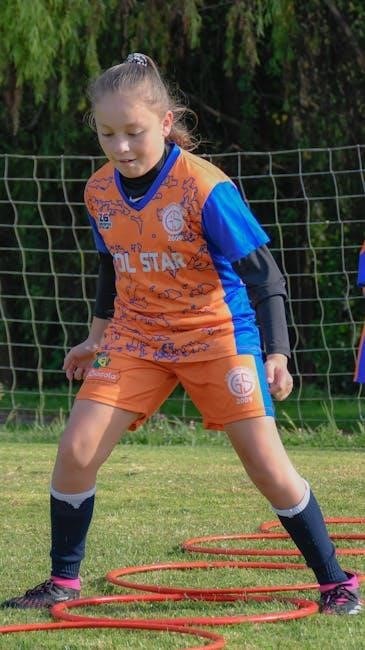
Short passing techniques are essential for maintaining possession and building attacks. These drills focus on precision, using the inside of the foot to deliver accurate, low-paced passes. Players practice passing with different angles and distances, emphasizing ball control and quick decision-making. Drills often involve pairs or small groups, encouraging communication and movement off the ball; Wall pass and give-and-go exercises are common, simulating game scenarios where quick, precise passes are crucial. These techniques improve teamwork, spatial awareness, and the ability to execute passes under pressure, making them a cornerstone of effective soccer practice.
Long Ball Passing Drills
Long ball passing drills focus on delivering accurate passes over longer distances, enhancing power and precision. Players practice using the laces to strike the ball firmly, ensuring it travels straight and reaches the target. Drills include stationary long passes, dynamic passing while moving, and game-like scenarios where players must pass under pressure. These exercises improve vision, strength, and timing, helping players develop the ability to switch play or find teammates in advanced positions. Incorporating these drills into practice ensures players can effectively execute long balls during matches, creating scoring opportunities and controlling the game’s tempo.
Wall Pass Drill
The wall pass drill is an excellent exercise for improving passing accuracy, control, and teamwork. Players pair up, standing 5-10 yards apart, and practice passing the ball back and forth using the inside of their foot. Emphasize quick exchanges, proper ball placement, and clear communication. Gradually increase the distance to challenge accuracy. This drill enhances decision-making and timing, simulating game situations where precise passing is crucial. Incorporating movement adds complexity, replicating match scenarios where players must adapt to different angles and pressures while maintaining control and composure.
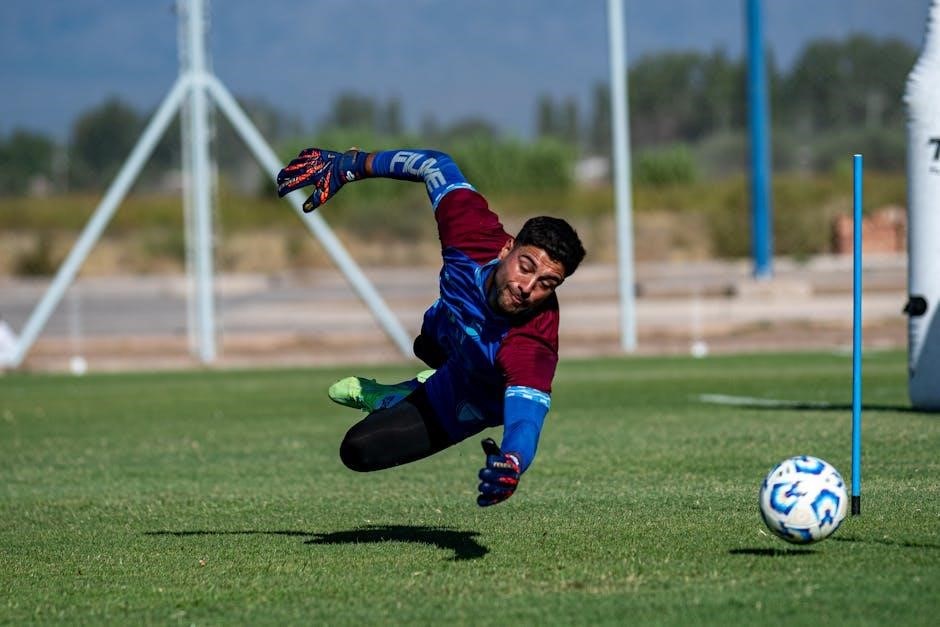
Shooting Drills
Shooting drills focus on improving accuracy, power, and technique. Players practice short-range, mid-range, and long-range shots, emphasizing proper foot placement and follow-through. These exercises enhance scoring ability in game-like scenarios.
Accuracy Shooting Drills
Accuracy shooting drills focus on precise ball placement and control. Players practice shooting from various distances and angles, aiming for specific targets like cones or small goals. These exercises emphasize proper foot placement, body alignment, and follow-through to ensure consistent accuracy. Coaches often incorporate stationary and moving drills to mimic game scenarios, helping players develop composure and reliability in front of goal. Regular practice improves a player’s ability to score from both close-range and long-distance opportunities, making them a more effective attacker during matches.
Power Shooting Drills
Power shooting drills are designed to enhance a player’s ability to strike the ball with strength and velocity. These exercises focus on proper technique, including leg strength, body weight transfer, and ball striking. Players practice shooting from distance, using drills like long-range shots, volleys, and powerful instep drives. Coaches often incorporate resistance bands or weighted balls to build leg power. These drills help develop the confidence and physicality needed to score from outside the box, making players a threat in various game situations and improving their overall scoring ability.
Breakaway Shooting Drill
The breakaway shooting drill simulates one-on-one situations between an attacker and a goalkeeper. Players start 20-30 yards from the goal, with the attacker in possession of the ball and a defender applying pressure. The attacker must dribble towards the goal, maintaining control while creating scoring opportunities. This drill emphasizes speed, decision-making, and accurate shooting under pressure. After each attempt, players rotate roles to ensure everyone practices both offensive and defensive skills. This exercise improves shooting accuracy, composure, and the ability to capitalize on breakaway chances in game-like scenarios.
Defensive Drills
Defensive drills focus on enhancing positioning, tackling, and communication. They improve reaction time and teamwork, ensuring a solid backline.
Basic Defensive Stance and Movement
A proper defensive stance is foundational for stability and reaction. Players should stand with knees slightly bent, weight forward, and feet shoulder-width apart. This stance allows quick lateral movement and balance. Footwork drills, such as shuffling and backpedaling, improve agility. Defensive movement emphasizes staying low, balanced, and alert. Coaches teach players to watch the ball and opponent simultaneously, anticipating moves. Proper body positioning helps in cutting off attacking angles. These techniques are essential for effective individual and team defense, building a strong defensive foundation. Regular practice reinforces muscle memory and sharpens instincts.
1v1 Defensive Drill
The 1v1 defensive drill focuses on individual defensive skills in a game-like scenario. Set up a 10×10-yard grid with one defender and one attacker. The attacker starts with the ball, and the defender must apply pressure while maintaining proper stance and positioning; The drill emphasizes staying balanced, using lateral movement, and forcing the attacker into a less dangerous position. Coaches can add variations, such as a second defender or time limits, to increase complexity. This drill improves defensive reaction time, decision-making, and the ability to contain or win the ball effectively in one-on-one situations. Regular practice enhances confidence and tactical awareness.
Containment Drill
The containment drill is designed to improve defensive players’ ability to slow down and restrict an opponent’s attack. Set up in a 10×10-yard area, a defender starts 5 yards away from an attacker with the ball. The defender’s goal is to contain the attacker, preventing them from advancing while applying controlled pressure. The drill encourages proper body positioning, footwork, and decision-making. Variations include adding cones or a second attacker to simulate game scenarios. This exercise helps defenders develop spatial awareness, patience, and the ability to dictate the attacker’s movement. Consistent practice enhances defensive composure and reduces vulnerabilities in one-on-one situations.
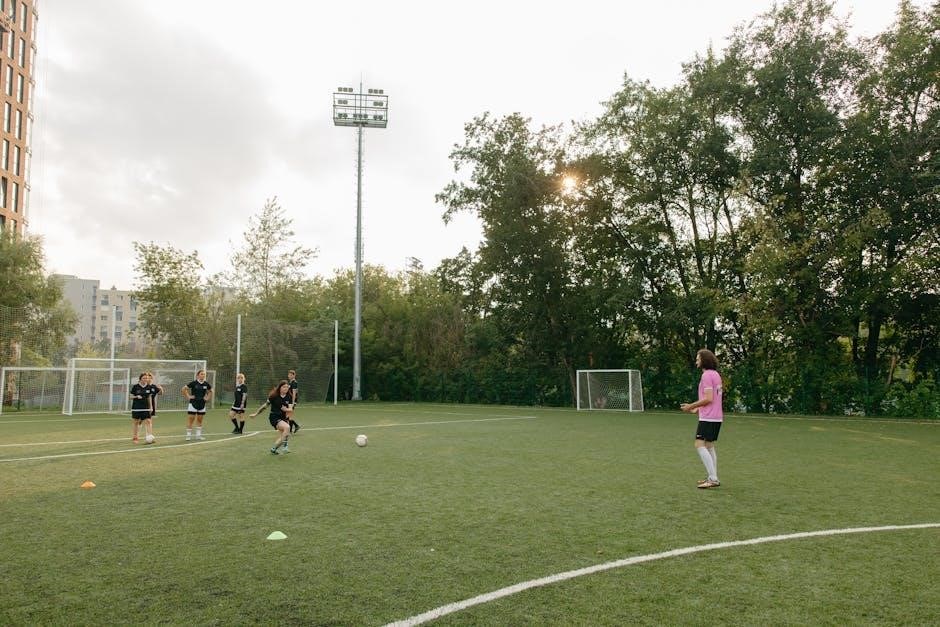
Team Play Drills
Team play drills focus on improving coordination, communication, and tactical awareness among players. They involve passing sequences, movement exercises, and small-sided games to enhance collective performance and strategy execution.
Passing and Movement Drill
This drill enhances teamwork, coordination, and tactical awareness. Set up a medium-sized area with cones marking corners. Players start at one corner, passing the ball to teammates while moving into open spaces. Emphasize one-touch passes to create quick transitions and scoring opportunities. Rotate players to practice different positions and maintain possession. Encourage communication and decision-making to simulate game scenarios effectively.
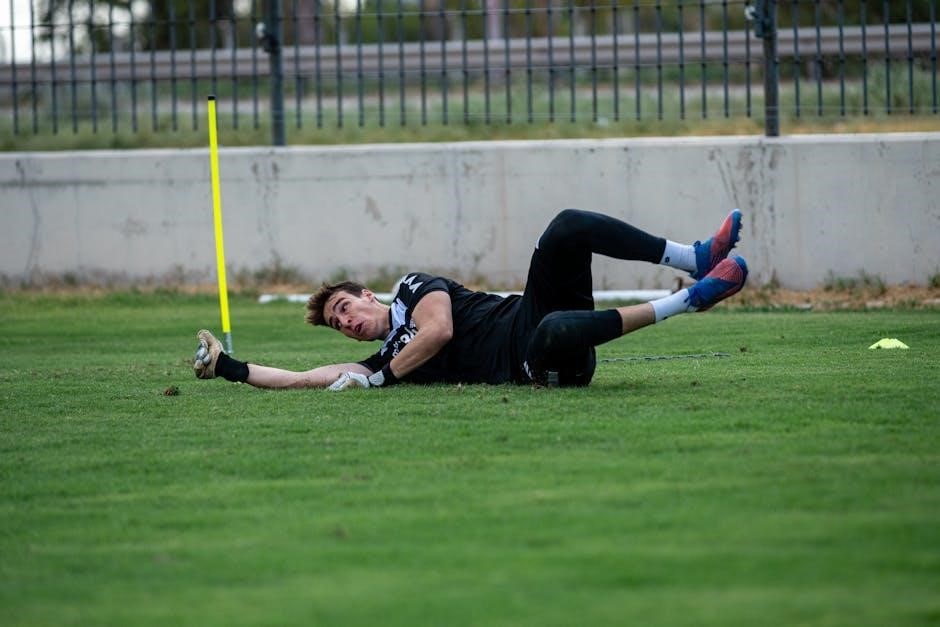
Small-Sided Games
Small-sided games are essential for improving soccer skills in a dynamic, game-like environment. Formats like 3v3 or 4v4 reduce field size and player numbers, increasing ball touches and decision-making opportunities. These games focus on teamwork, spatial awareness, and quick transitions. Players learn to adapt strategies, communicate effectively, and execute skills under pressure. Coaches can modify rules, such as no offside or limited dribbling, to emphasize specific skills. Small-sided games are versatile, suitable for all skill levels, and highly effective for developing match-ready players. They bridge the gap between drills and full-sided matches seamlessly.
Scrimmage Drills
Scrimmage drills simulate real match conditions, allowing players to apply skills in a competitive environment. They involve small-sided or full-team games with reduced rules, focusing on strategy and teamwork. Scrimmages help improve decision-making, positioning, and adaptability. Coaches can customize scenarios, such as attacking vs. defending or specific set-pieces, to target areas needing improvement. These drills enhance game sense and foster communication. Players learn to execute tactics, maintain possession, and capitalize on scoring opportunities. Scrimmages are dynamic tools that bridge the gap between isolated drills and actual competition, preparing players for the unpredictability of live matches effectively.
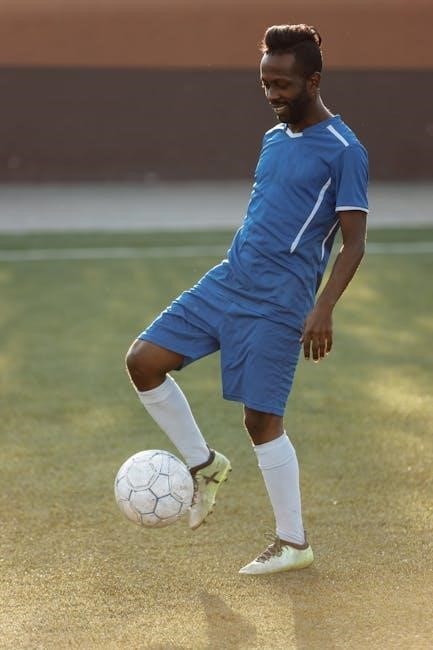
Goalkeeping Drills
Goalkeeping drills enhance reflexes, agility, and decision-making, preparing keepers for game situations through focused exercises on handling, footwork, and shot stopping effectively.
Basic Goalkeeping Stance and Footwork
A proper goalkeeping stance is essential for stability and quick reactions. Keepers should stand with feet shoulder-width apart, knees slightly bent, and weight forward. Footwork drills, such as carioca drills and lateral shuffles, improve agility and positioning. Practicing these fundamentals ensures keepers can move effectively across the goal line. Incorporating balance exercises strengthens core stability, crucial for making sharp movements. Regular repetition of these drills builds muscle memory, enabling keepers to focus on reading the game and making split-second decisions during matches. Mastering the basics is the foundation for advanced goalkeeping skills.
Handling and Catching Drills
Handling and catching drills are vital for goalkeepers to develop secure ball control. Start with high ball catches, focusing on proper hand positioning and body alignment. Ground ball pickups and volley catches improve reaction time and accuracy. Partner drills, where a teammate serves the ball, simulate game-like situations. Progress to dynamic drills, such as moving while catching, to enhance agility and coordination. Emphasize proper technique to prevent injuries and ensure confident handling. Incorporate glove work and body positioning exercises to refine skills. Regular practice builds consistency and reduces errors, making keepers more reliable in critical moments during matches.
Shot Stopping Drills
Shot stopping drills are essential for goalkeepers to master the art of preventing goals. Begin with stationary shots from varying distances to improve reaction time and precision. Progress to angled shots and dynamic movements, simulating game scenarios. Incorporate breakaway drills, where attackers attempt to score one-on-one. Focus on proper diving techniques, body positioning, and explosive movements. Use small-sided games to apply pressure and test decision-making under duress. These drills enhance reflexes, confidence, and the ability to read opponents, ensuring keepers are prepared for high-intensity match situations and can consistently make critical saves.
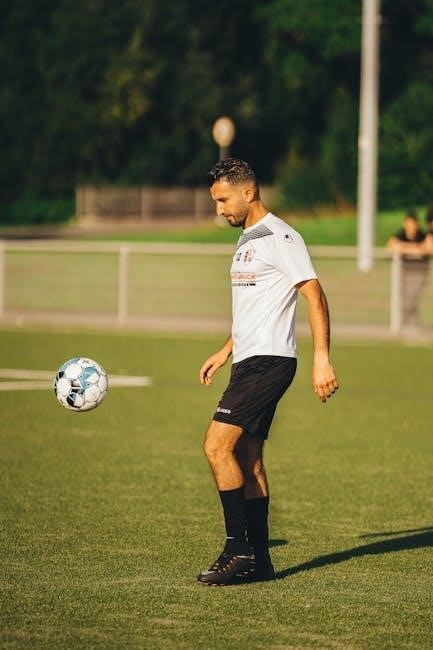
Practice Plans and Schedules
Structured practice plans are detailed blueprints for training sessions, outlining warm-ups, drills, and scrimmages. They balance skill development with physical conditioning, ensuring players improve efficiently. Schedules should be tailored to team objectives and player skill levels, with clear timelines for drills and rest periods. Consistency and adaptability are key to maximizing progress and maintaining player engagement throughout the season.
Sample Practice Plan for Beginners
A beginner-friendly practice plan focuses on foundational skills and gradual progression. Start with a 10-minute warm-up, including light jogging and dynamic stretches. Dedicate 15 minutes to ball control drills, such as dribbling through cones or basic ball manipulation exercises. Next, allocate 20 minutes to passing techniques, emphasizing short, accurate passes in pairs or small groups. Include a 15-minute small-sided game (e.g., 3v3) to apply skills in real-game scenarios. Conclude with a 5-minute cool-down, stretching key muscle groups; This structured approach ensures players build confidence and mastery of basic soccer skills in a supportive environment.
Sample Practice Plan for Intermediate Players
An intermediate practice plan builds on foundational skills while introducing more complexity. Begin with a 15-minute warm-up, including dynamic stretches and light cardio. Dedicate 20 minutes to advanced ball control drills, such as figure-eight dribbling and cone weaving. Next, focus on passing accuracy with 20 minutes of long-range and moving-target drills. Incorporate a 25-minute tactical session, including 2v2 or 3v3 games to emphasize teamwork and decision-making; Conclude with a 10-minute cool-down, highlighting stretching and hydration. This plan challenges players to refine their skills while preparing for game-like scenarios.
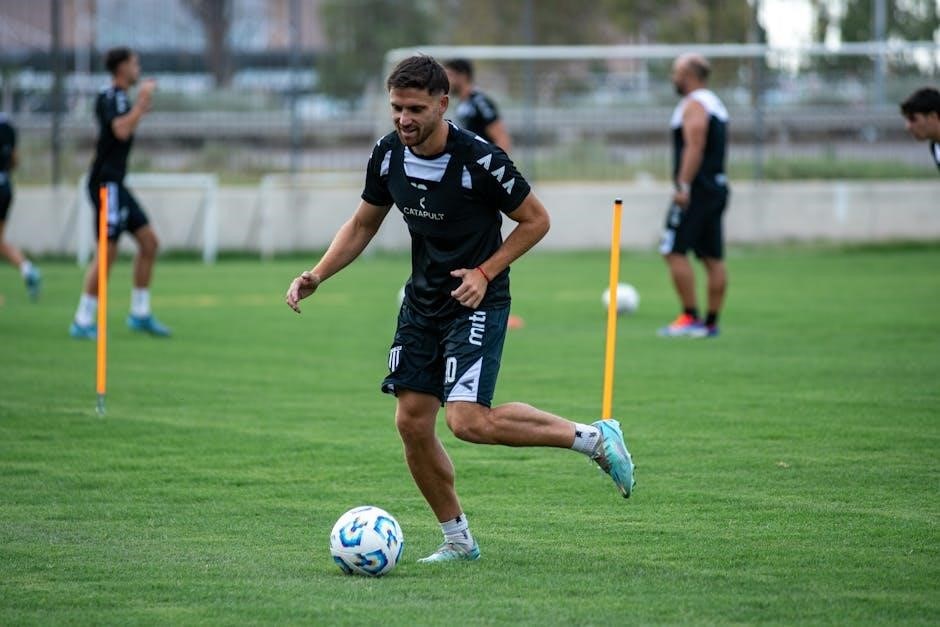
Sample Practice Plan for Advanced Players
An advanced practice plan focuses on refining techniques and increasing intensity. Begin with a 15-minute dynamic warm-up, emphasizing explosive movements and agility. Spend 25 minutes on technical drills, such as small-sided games (3v3) and high-intensity interval training (HIIT). Dedicate 25 minutes to tactical awareness, including positional play and set-piece strategies. Conclude with a 10-minute cool-down, incorporating stretching and hydration. This plan challenges advanced players to enhance their fitness, precision, and game intelligence, preparing them for competitive match scenarios.
Adapting Drills to Different Skill Levels
Adapting soccer drills to different skill levels involves modifying difficulty, duration, and focus. Simplify for beginners with shorter, slower-paced sessions, while advanced players benefit from complex, high-speed exercises. Adjust rules and equipment to suit abilities, providing targeted feedback to enhance learning and performance across all levels effectively.
Modifying Drills for Youth Players
Modifying drills for youth players involves simplifying techniques, reducing complexity, and emphasizing fun. Use smaller spaces, lighter balls, and shorter sessions to suit their attention spans and physical abilities. Incorporate games and visual aids to enhance engagement and understanding. Focus on basic skills like dribbling, passing, and shooting, using age-appropriate challenges. Ensure drills promote teamwork, creativity, and confidence while maintaining safety. Break drills into manageable steps, offer positive feedback, and celebrate progress to foster a love for the game and encourage continuous improvement in a supportive environment.
Increasing Difficulty for Advanced Players
To challenge advanced players, drills should incorporate higher intensity, complexity, and realism. Increase the tempo of exercises, add more defenders or opponents, and introduce advanced techniques like step-overs or feints. Incorporate game-like scenarios, such as breaking down defenses or high-press situations, to simulate match conditions. Reduce recovery time between repetitions and add multi-tasking challenges, like combining dribbling with decision-making. Introduce variable conditions, such as uneven numbers or limited space, to enhance problem-solving and adaptability. This approach ensures advanced players are continually tested and prepared for competitive environments, fostering elite-level performance and mental sharpness.
Final Thoughts on Effective Soccer Practice Drills
Effective soccer practice drills are the backbone of player development. Consistency and proper planning ensure steady improvement. Drills refine skills like dribbling, passing, and shooting, while fostering teamwork. Goalkeepers and defenders also benefit from specialized exercises. Adaptability is key; coaches should tailor drills to suit different skill levels. Whether for youth or advanced players, structured practices build confidence and strategy. Dedication to these drills leads to measurable progress and success on the field. Embrace the process, stay committed, and watch your team thrive.
Encouragement to Implement the Drills
Implementing soccer practice drills consistently is crucial for player development and team success. These exercises enhance technical skills, build teamwork, and boost confidence. Start with basic drills and gradually increase difficulty as players progress. Set clear goals and track improvements to stay motivated. A well-structured practice plan ensures every session is productive. Encourage players to embrace challenges and enjoy the process of growth. With dedication and persistence, the benefits of these drills will shine on the field. Take the first step today and watch your team flourish.